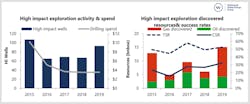Drillers improving exploration performance, report finds
Offshore staff
LONDON – Westwood Global Energy Group’s ‘State of Exploration 2020’ report reveals an increase in drilling globally last year, with improved performance in 2019.
The number of high-impact wells drilled rose 39% compared with 2018, with more than 15 Bboe discovered and commercial success rates of 32%, the highest in at least 10 years.
Westwood identified 28 potentially commercial discoveries with resources above 100 MMboe, almost double the number in 2018 and the highest since 2014.
The four largest were gas or gas condensate in Iran, Russia, Mauritania, and Cyprus, and there were also eight oil discoveries containing more than 200 MMbbl, including three offshore Guyana.
Over the past five years the top three plays pursued all emerged through frontier drilling successes of Mauritania/Senegal, Guyana, and Egypt, and 11 of the top 16 discoveries last year came from emerging plays.
Stratigraphic traps - traps without a structural component - have become increasingly important, and less risky than before. The proportion of wells targeting stratigraphic trap prospects has doubled over the last five years, Westwood said, while the commercial success rates, at 41%, have been significantly higher than other types of traps.
Since 2008 51% of discovered high impact resources remains undeveloped, with no sign of progress on 34 Bboe of potentially commercial resource proven between 2008-2016.
According to Westwood’s Keith Myers and Graeme Bagley, this presents a significant opportunity for exploration if the barriers to commercialization can be removed.
In 2019, NOCs and the supermajors participated in 80% of the high-impact wells drilled. At the same time, the energy transition and capital constraints have persuaded increasing numbers of companies to veer away from frontier wildcats toward short-cycle, infrastructure-led exploration.
Infrastructure-led, near-field drilling typically involves three years from discovery to first production, but there are limits to the number of drillable prospects within tieback distance, the authors said, and high-impact discoveries in mature basins are rare.
Those that can invest in exploration counter cyclically, they added, can take advantage of the current conditions to renew their portfolios. Competition is lower and governments keener to sustain exploration, while at the same time there are distressed companies with assets to sell.
Equity valuations are so low, a corporate acquisition may be the lowest-cost solution to portfolio renewal.
The authors conclude that there is still a business case for exploration despite these difficult times. But explorers will have to focus on finding low cost, low emissions oil and gas to prosper in the coming energy transition to come.
05/20/2020
